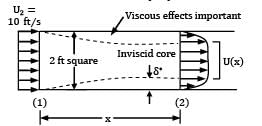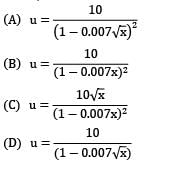Civil Engineering (CE) Exam > Civil Engineering (CE) Questions > Air flowing into a 2-ft–square duct with a u...
Start Learning for Free
Air flowing into a 2-ft–square duct with a uniform velocity of 10 ft/s forms a boundary layer on the walls as shown in Fig. The fluid within the core region (outside the boundary layers) flows as if it were inviscid. From advanced calculations it is determined that for this flow the boundary layer displacement thickness is given by δ∗ = 0.0070(x)1⁄2 where δ∗ and x are in feet. Determine the velocity U = U(x) of the air within the duct but outside of the boundary layer.


Correct answer is 'A'. Can you explain this answer?
| FREE This question is part of | Download PDF Attempt this Test |
Verified Answer
Air flowing into a 2-ft–square duct with a uniform velocity of 10 ft/...
If we assume incompressible flow (a reasonable assumption because of the low velocities involved), it follows that the volume flowrate across any section of the duct is equal to that at the entrance (i. e. , Q1 = Q2). That is,


View all questions of this test

According to the definition of the displacement thickness, δ∗, the flowrate across section (2) is the same as that for a uniform flow with velocity U through a duct whose walls have been moved inward by δ∗. That is,

By combining Equations (1) and (2) we obtain

Most Upvoted Answer
Air flowing into a 2-ft–square duct with a uniform velocity of 10 ft/...
If we assume incompressible flow (a reasonable assumption because of the low velocities involved), it follows that the volume flowrate across any section of the duct is equal to that at the entrance (i. e. , Q1 = Q2). That is,



According to the definition of the displacement thickness, δ∗, the flowrate across section (2) is the same as that for a uniform flow with velocity U through a duct whose walls have been moved inward by δ∗. That is,

By combining Equations (1) and (2) we obtain

Free Test
| FREE | Start Free Test |
Community Answer
Air flowing into a 2-ft–square duct with a uniform velocity of 10 ft/...
If we assume incompressible flow (a reasonable assumption because of the low velocities involved), it follows that the volume flowrate across any section of the duct is equal to that at the entrance (i. e. , Q1 = Q2). That is,



According to the definition of the displacement thickness, δ∗, the flowrate across section (2) is the same as that for a uniform flow with velocity U through a duct whose walls have been moved inward by δ∗. That is,

By combining Equations (1) and (2) we obtain

Attention Civil Engineering (CE) Students!
To make sure you are not studying endlessly, EduRev has designed Civil Engineering (CE) study material, with Structured Courses, Videos, & Test Series. Plus get personalized analysis, doubt solving and improvement plans to achieve a great score in Civil Engineering (CE).

|
Explore Courses for Civil Engineering (CE) exam
|

|
Similar Civil Engineering (CE) Doubts
Air flowing into a 2-ft–square duct with a uniform velocity of 10 ft/s forms a boundary layer on the walls as shown in Fig. The fluid within the core region (outside the boundary layers) flows as if it were inviscid. From advanced calculations it is determined that for this flow the boundary layer displacement thickness is given by δ∗ = 0.0070(x)1⁄2 where δ∗ and x are in feet. Determine the velocity U = U(x) of the air within the duct but outside of the boundary layer.Correct answer is 'A'. Can you explain this answer?
Question Description
Air flowing into a 2-ft–square duct with a uniform velocity of 10 ft/s forms a boundary layer on the walls as shown in Fig. The fluid within the core region (outside the boundary layers) flows as if it were inviscid. From advanced calculations it is determined that for this flow the boundary layer displacement thickness is given by δ∗ = 0.0070(x)1⁄2 where δ∗ and x are in feet. Determine the velocity U = U(x) of the air within the duct but outside of the boundary layer.Correct answer is 'A'. Can you explain this answer? for Civil Engineering (CE) 2024 is part of Civil Engineering (CE) preparation. The Question and answers have been prepared according to the Civil Engineering (CE) exam syllabus. Information about Air flowing into a 2-ft–square duct with a uniform velocity of 10 ft/s forms a boundary layer on the walls as shown in Fig. The fluid within the core region (outside the boundary layers) flows as if it were inviscid. From advanced calculations it is determined that for this flow the boundary layer displacement thickness is given by δ∗ = 0.0070(x)1⁄2 where δ∗ and x are in feet. Determine the velocity U = U(x) of the air within the duct but outside of the boundary layer.Correct answer is 'A'. Can you explain this answer? covers all topics & solutions for Civil Engineering (CE) 2024 Exam. Find important definitions, questions, meanings, examples, exercises and tests below for Air flowing into a 2-ft–square duct with a uniform velocity of 10 ft/s forms a boundary layer on the walls as shown in Fig. The fluid within the core region (outside the boundary layers) flows as if it were inviscid. From advanced calculations it is determined that for this flow the boundary layer displacement thickness is given by δ∗ = 0.0070(x)1⁄2 where δ∗ and x are in feet. Determine the velocity U = U(x) of the air within the duct but outside of the boundary layer.Correct answer is 'A'. Can you explain this answer?.
Air flowing into a 2-ft–square duct with a uniform velocity of 10 ft/s forms a boundary layer on the walls as shown in Fig. The fluid within the core region (outside the boundary layers) flows as if it were inviscid. From advanced calculations it is determined that for this flow the boundary layer displacement thickness is given by δ∗ = 0.0070(x)1⁄2 where δ∗ and x are in feet. Determine the velocity U = U(x) of the air within the duct but outside of the boundary layer.Correct answer is 'A'. Can you explain this answer? for Civil Engineering (CE) 2024 is part of Civil Engineering (CE) preparation. The Question and answers have been prepared according to the Civil Engineering (CE) exam syllabus. Information about Air flowing into a 2-ft–square duct with a uniform velocity of 10 ft/s forms a boundary layer on the walls as shown in Fig. The fluid within the core region (outside the boundary layers) flows as if it were inviscid. From advanced calculations it is determined that for this flow the boundary layer displacement thickness is given by δ∗ = 0.0070(x)1⁄2 where δ∗ and x are in feet. Determine the velocity U = U(x) of the air within the duct but outside of the boundary layer.Correct answer is 'A'. Can you explain this answer? covers all topics & solutions for Civil Engineering (CE) 2024 Exam. Find important definitions, questions, meanings, examples, exercises and tests below for Air flowing into a 2-ft–square duct with a uniform velocity of 10 ft/s forms a boundary layer on the walls as shown in Fig. The fluid within the core region (outside the boundary layers) flows as if it were inviscid. From advanced calculations it is determined that for this flow the boundary layer displacement thickness is given by δ∗ = 0.0070(x)1⁄2 where δ∗ and x are in feet. Determine the velocity U = U(x) of the air within the duct but outside of the boundary layer.Correct answer is 'A'. Can you explain this answer?.
Solutions for Air flowing into a 2-ft–square duct with a uniform velocity of 10 ft/s forms a boundary layer on the walls as shown in Fig. The fluid within the core region (outside the boundary layers) flows as if it were inviscid. From advanced calculations it is determined that for this flow the boundary layer displacement thickness is given by δ∗ = 0.0070(x)1⁄2 where δ∗ and x are in feet. Determine the velocity U = U(x) of the air within the duct but outside of the boundary layer.Correct answer is 'A'. Can you explain this answer? in English & in Hindi are available as part of our courses for Civil Engineering (CE).
Download more important topics, notes, lectures and mock test series for Civil Engineering (CE) Exam by signing up for free.
Here you can find the meaning of Air flowing into a 2-ft–square duct with a uniform velocity of 10 ft/s forms a boundary layer on the walls as shown in Fig. The fluid within the core region (outside the boundary layers) flows as if it were inviscid. From advanced calculations it is determined that for this flow the boundary layer displacement thickness is given by δ∗ = 0.0070(x)1⁄2 where δ∗ and x are in feet. Determine the velocity U = U(x) of the air within the duct but outside of the boundary layer.Correct answer is 'A'. Can you explain this answer? defined & explained in the simplest way possible. Besides giving the explanation of
Air flowing into a 2-ft–square duct with a uniform velocity of 10 ft/s forms a boundary layer on the walls as shown in Fig. The fluid within the core region (outside the boundary layers) flows as if it were inviscid. From advanced calculations it is determined that for this flow the boundary layer displacement thickness is given by δ∗ = 0.0070(x)1⁄2 where δ∗ and x are in feet. Determine the velocity U = U(x) of the air within the duct but outside of the boundary layer.Correct answer is 'A'. Can you explain this answer?, a detailed solution for Air flowing into a 2-ft–square duct with a uniform velocity of 10 ft/s forms a boundary layer on the walls as shown in Fig. The fluid within the core region (outside the boundary layers) flows as if it were inviscid. From advanced calculations it is determined that for this flow the boundary layer displacement thickness is given by δ∗ = 0.0070(x)1⁄2 where δ∗ and x are in feet. Determine the velocity U = U(x) of the air within the duct but outside of the boundary layer.Correct answer is 'A'. Can you explain this answer? has been provided alongside types of Air flowing into a 2-ft–square duct with a uniform velocity of 10 ft/s forms a boundary layer on the walls as shown in Fig. The fluid within the core region (outside the boundary layers) flows as if it were inviscid. From advanced calculations it is determined that for this flow the boundary layer displacement thickness is given by δ∗ = 0.0070(x)1⁄2 where δ∗ and x are in feet. Determine the velocity U = U(x) of the air within the duct but outside of the boundary layer.Correct answer is 'A'. Can you explain this answer? theory, EduRev gives you an
ample number of questions to practice Air flowing into a 2-ft–square duct with a uniform velocity of 10 ft/s forms a boundary layer on the walls as shown in Fig. The fluid within the core region (outside the boundary layers) flows as if it were inviscid. From advanced calculations it is determined that for this flow the boundary layer displacement thickness is given by δ∗ = 0.0070(x)1⁄2 where δ∗ and x are in feet. Determine the velocity U = U(x) of the air within the duct but outside of the boundary layer.Correct answer is 'A'. Can you explain this answer? tests, examples and also practice Civil Engineering (CE) tests.

|
Explore Courses for Civil Engineering (CE) exam
|

|
Suggested Free Tests
Signup for Free!
Signup to see your scores go up within 7 days! Learn & Practice with 1000+ FREE Notes, Videos & Tests.
























